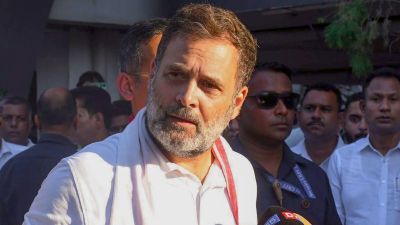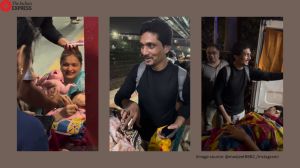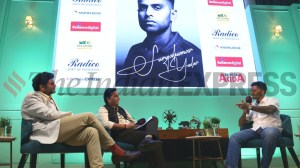Mount Politics meets Mount Media
It is hard to imagine that vol 188 no 12 of a fashion magazine could say so much about America. There is no Bill Clinton, no Ken Starr, no M...

It is hard to imagine that vol 188 no 12 of a fashion magazine could say so much about America. There is no Bill Clinton, no Ken Starr, no Monica Lewinsky. No supermodel, no movie star, no John Glenn, no Michael Jordan. Instead, there is Hillary Clinton. The latest edition of Vogue is one of those documents that people will stash in the attic, alongside coverage of the first moon landing. It doesn’t recount an event, it is an event — an affirmation by a triumvirate of women who have become a parallel power structure within America, a resplendent counterpoint to the tedium of presidential impeachment.
This triad of women is more closely knit — personally, culturally and politically — than that of Clinton, Starr and Judiciary Committee chairman Henry Hyde. And is a lot more glamorous: while America yawns at the continuing boudoir farce in Congress, it seems dazzled by what Vogue is serving up. The triad is Anna Wintour, editor-in-chief of Vogue, Annie Leibovitz, photographer to the stars, and First LadyHillary Clinton.
While the President’s sex life is trawled through yet again by the Judiciary Committee, his wife has climbed the highest pedestal known to woman — the cover of Vogue. It is the first time in the magazine’s 110-year history that it has featured a First Lady as cover girl.
“She is absolutely thrilled with the pictures,” says Wintour. No wonder. But what a lot these pictures say. First, as Wintour says, that “she is our woman of the year”. Second, they are an affirmation of the extraordinary and unexpected tidal wave of popularity that has engulfed the First Lady.Away from Leibovitz’s lights and lenses, there is talk of Hillary as the ideal candidate for the New York Senate seat to be vacated by Daniel Pat Moynihan in 2000 — or even for the White House, with husband Bill (if he remains that) as sidekick “Cut Out the Middle Man”, says one sticker: “Hillary for President.”
It is well known that magazine mogul S.I. Newhouse — Wintour’s boss — likes to model his Conde Nast empireon a Hollywood studio. And there is that feel about the way the triumvirate has produced this remarkable document: Wintour as producer, Leibovitz as director — and Hillary as, well, the prima donna, the star. Wintour doubles as casting director and chooses the star, month after month. And not even Hollywood’s finest can have had so few refusals. “It is everyone’s dream to be on the cover of Vogue,” Wintour says.
Even so, it must be strange to be able to say of the First Lady, as Wintour did: “She was kind enough to put herself in our hands.” It is an odd reflection of how the cultural pecking order works in a media age, between the White House and the New York magazines. But it is an accurate one. Wintour may not make the nitty-gritty decisions that steer the lives of Americans, but she can mould the images of those who make the decisions — or at least those she likes or respects. Such as Hillary Clinton.
This is Wintour’s tenth year as editor-in-chief at Vogue. In New York she has so outrun theBritpack that famously dominates Manhattan’s glossies that she has ceased to belong to it. Tina Brown, Harry Evans, Andrew Sullivan et al have shuffled from one chair to another or moved on, while Wintour stays behind the same desk. Her friendship with Leibovitz could be attributed to professional predestination, but the relationship with Hillary Clinton is more complicated. “This is above power and politics,” she says, using both words in their narrowest sense. And she is right; the two women look at each other across the valley of America from two peaks, one called Mount Politics, the other called Mount Media. “It would be a bit precocious to say I was the First Lady’s friend,” Wintour says, very correctly — but she is. In 1996, they teamed up for a fashion sale at the White House in aid of something called `Fashion Targets Breast Cancer’.
Just as the Lewinsky scandal was exploding in the First Lady’s face, Wintour starred at a ball for Tony and Cherie Blair, the invitation very definitely fromHillary. The two women share the same hairdresser in Washington, and if you are Anna Wintour, that is no minor detail.
We need to remind ourselves that eight years ago, Hillary Clinton was a frump. She was a bespectacled attorney married to a Governor convinced for some time he would become President. There was a makeover, of sorts, then a Hillary reinvented and groomed for the White House. For the first years of the administration, Hillary was seen by many Americans as a Lady Macbeth figure. She was proud of the fact that she couldn’t bake cookies, and America didn’t take kindly to that. To a minority, Hillary was the great white hope for socialised medicine, but to most she was a scapegoat, a scheming witch stirring a socialist brew in a stubbornly individualistic society.
The spinmeisters of President Clinton’s middle years accordingly restyled her as compassionate woman — a Florence Nightingale for soldiers with Gulf War Syndrome, a motherly author of children’s books and star of children’s TV.Wintour and Leibovitz, however, remained with the Hillary they knew. She reappeared in Vogue, accompanied on the recent presidential tour of Africa.By then, the White House was a stockade as the Lewinsky scandal laid siege. It was the start of what should have been a nightmare. On the weekend that the allegations were first made, Hillary took the reins. She did so again before her husband faced the nation on television; and again when the Starr report was published. The nation was bored by the scandal, but captivated by Hillary. The spinmeisters could hardly fail to notice, and turned their earlier judgment upside down for the recent election campaign — keeping the President on a tight rein on the South Lawn and sending Hillary to the hustings. Wintour had an idea: Leibovitz on the highways and byways with Hillary.
“Then it turned into something bigger,” says Wintour. “The way people felt about her was remarkable”. The story was full of Hillary alighting from the bus to buy an ice-cream; Hillary sayingshe preferred live audiences to TV; Hillary’s “voracious curiosity about the world around her”. And so that “something bigger” was to reflect a mood abroad of “Hillary, Regardless”. Or as Wintour says: “A celebration of her, after the year she has had. A vindication of her beauty and her success as a woman. Most people who saw the pictures said they’d never seen her looking so good”.






- 01
- 02
- 03
- 04
- 05

























